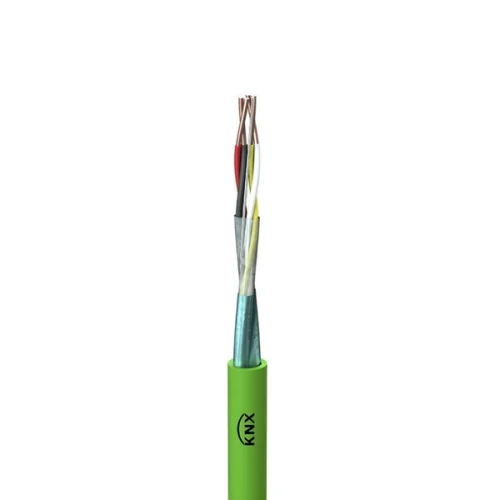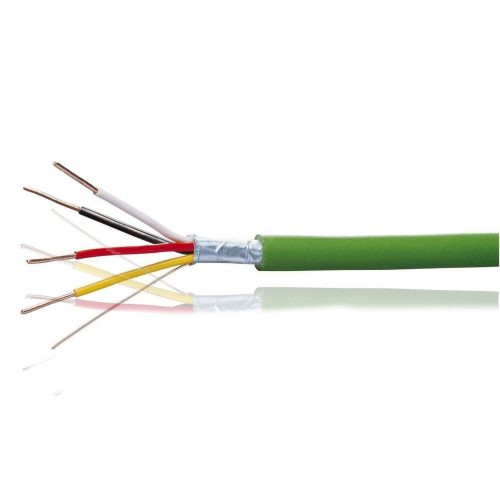What Is KNX Cable and Why Is It Critical for Smart Buildings?
Imagine walking into a building where the lights adjust to the natural daylight, the temperature always feels just right, and energy use is carefully managed without you even noticing. Behind this smooth experience is not just smart devices but the hidden backbone that makes it all possible, the KNX cable.
This blog will explore what KNX cable is and why it is critical for smart buildings. We will break it down in simple terms so you can understand how it works, why it is trusted worldwide, and what makes it essential for modern building automation. You will also discover the many benefits KNX cables bring to energy efficiency, comfort, and reliability, along with the features that set them apart. By the end, you will see how KNX cables are not just wires but the nervous system of any truly smart building.
What Is a KNX Cable?
A KNX cable is a specially designed communication cable that connects different devices and systems in a smart building. It allows components like lighting, heating, ventilation, air conditioning, alarms and blinds to communicate with each other through a single standardized protocol known as KNX.
Key features of a KNX cable include:
- Twisted pair design to reduce interference.
- Reliable signal transmission over long distances.
- Compatibility with a wide range of automation devices.
- Durability to withstand challenging building environments.
- Easy Integration: Compatible with existing infrastructure, adapters and ports, making upgrades and replacements simple.

In simple terms, KNX cables are the backbone that allows smart devices to “talk” to each other.
Why Is KNX Cable Critical for Smart Buildings?
Smart buildings require a strong, reliable and flexible communication system. Here’s why KNX cable is essential:
1. Seamless Connectivity
Without a KNX cable, smart systems would not be able to integrate properly. Lighting, security, HVAC and energy management systems rely on smooth communication, which KNX ensures.
2. Energy Efficiency
A building with KNX cabling can intelligently manage energy consumption. For example:
- Lights turn off automatically when a room is empty.
- Air conditioning adjusts based on occupancy.
- Blinds open and close based on natural daylight.
This reduces energy costs and creates a sustainable environment.
3. Scalability and Flexibility
KNX systems are highly scalable. Whether it’s a small office or a large commercial tower, KNX cables can support expansion and upgrades without needing a complete overhaul.
4. Long-Term Reliability
Unlike wireless solutions that can face interference or connectivity issues, KNX cabling ensures stable and long-term performance.
5. Future-Proof Technology
KNX is a globally recognized standard for smart buildings. Choosing KNX cables means the building will remain compatible with future devices and technologies.
Applications of KNX Cable in Smart Buildings
KNX cables are used across many aspects of modern building automation. Some common applications include:

- Lighting Control: Automated dimming, scheduling and sensor-based lighting.
- Climate Control: Managing heating, ventilation, and air conditioning efficiently.
- Security Systems: Integration of alarms, CCTV and access controls.
- Shading and Blinds: Automated curtain and blind systems.
- Energy Monitoring: Real-time tracking of energy use and optimization.
By connecting all these systems, KNX creates buildings that are not only smarter but also safer and more cost-efficient.
Benefits of KNX Cabling for Smart Buildings
Choosing KNX cabling provides multiple benefits:
- Standardization: A globally accepted protocol that ensures compatibility.
- Ease of Installation: Simple wiring setup that reduces complexity.
- Cost Savings: Optimized energy usage leads to reduced operational costs.
- User Comfort: Creates an environment that adapts to user needs automatically.
- Safety and Security: Enhances protection with integrated monitoring systems.
Benefits of KNX Cabling for Smart Buildings
With technology evolving rapidly, KNX cables continue to play an important role in shaping building infrastructure. Some trending points include:
- Growing demand for energy-efficient automation.
- Integration of IoT devices with KNX systems.
- Use of KNX in both residential and commercial projects.
- Increased focus on sustainable building design.
These trends show why investing in KNX cabling is no longer optional but necessary for modern construction.
How to Choose the Right KNX Cable
When selecting a KNX cable, consider the following:
- Quality Standards: Ensure the cable meets KNX certification.
- Installation Needs: Choose cables suitable for walls, ceilings or underground.
- Durability: Opt for fire-resistant and long-lasting materials.
- Supplier Reliability: Work with trusted providers to ensure authentic products.

Conclusion
To sum up, smart buildings depend on intelligent systems that work together seamlessly, and KNX cables make this possible. They act as the foundation of modern automation, enabling energy savings, comfort, security and future-ready infrastructure.
If you are planning to design or upgrade a smart building, choosing KNX cabling is one of the most important decisions you can make. For reliable solutions and high-quality KNX cabling, Cable Zone Technology provides trusted products and services to support the growing demand for smarter, safer and more efficient buildings. Get in touch with us today to discuss your project requirements and find the best KNX cabling solutions for your building.
Quick Links
What we offer
- Commercially competitive prices
- Reliable & consistent quality
- Reliable & timely delivery
- A targeted stocking policy
- Technical support for Projects
Contact
- Shop No. S61 Ahmed Mohammed Baghlaf, Naif, Deira, Dubai, UAE
- +971 55 418 5686
- +971 4 558 4670
- cablezonetech@gmail.com
- sales@cablezonetechnology.com
Copyright © 2025 Cable Zone | All Rights Reserved. Powered by DEDOTE
